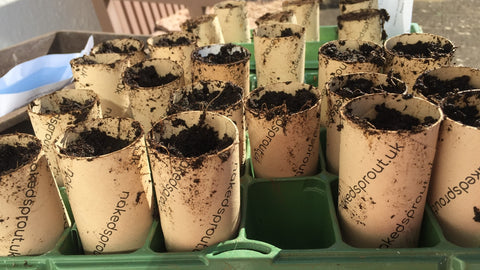Using Toilet Roll Tubes to Grow Seedlings!

Spring is well and truly on the way here in the UK and many of us are clearing plots, pots, and patches to make room for new growth.
So we thought we’d take the opportunity to highlight one of the less obvious ways toilet rolls can help out around the home, providing a good start for little seedlings! It’s not one of the more common uses of our products, but it’s one we always enjoy hearing about when our green-fingered customers get in touch. So let's dive into the world of gardening and explore how you can give these cardboard tubes a new lease on life as seedling starters, and more!

The Seedling Situation: Why Toilet Roll Tubes?
Most of the emails we receive to our support team are about our tissue, the sheets that go on our rolls and in our boxes. But every year, around this time of year, we also receive a few queries from customers who are planning to use our toilet roll tubes to start seedlings, and want to check if there’s any reason why they shouldn’t.
The theory is simple, you fill a toilet roll tube with soil and plant the seeds inside them, you can then keep them inside, or in a greenhouse, at relatively stable temperature until they’ve sturdy enough to withstand the changing weather and temperatures outside. After a few weeks your seedlings can be planted directly into the soil, roll and all, ready to grow to their full potential, and avoiding transplant shock.
DIY Seedling Starters: A Step-by-Step Guide
Okay so we know why we’re doing this, let’s get to it! Here's a simple guide to turn your toilet roll tubes into seedling starters:
Step 1: Check your tubes
Most unbleached cardboard inner tubes of the type used for toilet rolls are fine to plant in your garden. But if your inner tubes are of the more fancy variety, and have wording or patterns printed on them, it’s worth checking that the ink is soy-based or another environmentally-friendly alternative.

This picture was taken by one of our lovely customers, back when we used to print our name on our inner tubes with soy ink. We’ve cut that step out now as part of our drive to eliminate all unnecessary decoration and packaging, but if you still have some of these vintage Naked Sprout rolls lying around you can be assured that the soy-based dye we used to use won’t harm your seedlings or your soil.
Step 2: Tube gathering
All good? Okay time to hoard some toilet roll tubes! The average person in the UK uses about 127 rolls per year, so it shouldn’t take too long to get a decent pile together. At this stage we should apologise to our own customers - Naked Sprout rolls are twice the length of many toilet rolls out there, so it might take a bit longer in your case.
Step 3: Make the Base
Cut four half-inch slits at one end of each toilet roll tube, evenly spaced around the circumference. Fold these inwards to make a sturdy bottom for your little tube. This base will hold your soil and seedling in place.
Step 4: Fill 'em Up
You’ll need a compost mix to get your seedlings started. Your local garden centre will have bags for this specific purpose, and if you’ve got the right materials to hand you can make your own.
When you have your mix scoop some into each tube, gently pressing down to ensure it's snug and secure.

Step 5: Plant Your Seeds
Follow the planting instructions for your specific seeds. Typically, this involves placing 2-3 seeds in each tube and lightly covering them with a bit more soil, then watering to moisten the soil.
Step 6: Water and Wait
Place them on a sunny windowsill and keep an eye out, before too long they’ll start to sprout! In this early phase it’s a good idea to check in with your seedlings from time to time just to keep an eye out for mould. During this time the soil should be kept moist, but resist the temptation to overwater!
Step 7: Transition Time
The packet your seeds came in will let you know when the seedlings are good to plant out. The great thing about using toilet rolls is that, when the time comes, you can plant them directly in the ground, tube and all. Make sure the cardboard tube is completely buried to avoid drying out. It will typically take about two months to decompose, providing a lovely snack for worms and other garden helpers as it does!

In Conclusion
After all that we hope you’re feeling ready to get your hands dirty! Toilet roll tubes, often overlooked on their journey between our bathrooms and our recycling bins, are ready and waiting to be repurposed in the garden. So, the next time you're removing an empty tube from your toilet roll holder, remember its potential. Your seedlings, and the worms, will appreciate it. Happy gardening, and may your green thumb be ever greener!
Want to get your hands on some eco-friendly inner tubes surrounded by soft, unbleached toilet tissue?




